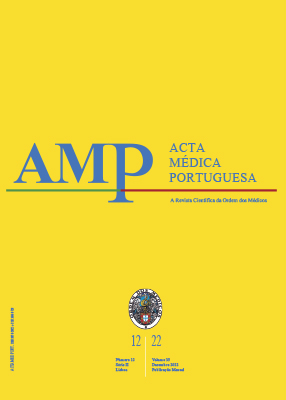Serratia marcescens Endocarditis: A Case Report and Literature Review
DOI:
https://doi.org/10.20344/amp.16377Keywords:
Endocarditis, Bacterial, Fever, Heart Valve Prosthesis, Positron-Emission Tomography, Serratia marcescensAbstract
Serratia marcescens is a rarely implicated agent in endocarditis. We describe a case of a patient that underwent aortic and mitral valve replacement for Streptococcus agalactiae endocarditis. Four months later, he was readmitted with an ischemic stroke and fever. Physical examination and repetitive transthoracic echocardiogram were unremarkable. The initial blood cultures were negative. Due to sustained fever, vancomycin, gentamicin and piperacillin-tazobactam were initiated. On subsequent blood cultures, Serratia marcescens was isolated and antibiotics switched to ertapenem and gentamicin. In addition to cerebral emboli, a splenic embolus was found. The PET/CT revealed an abnormal hypercaptation in the mitral bioprosthesis. The patient was treated for six weeks. There are no current specific recommendations regarding the treatment of Serratia marcescens endocarditis. It is widely accepted that treatment should be prolonged and include a combination of antimicrobial agents. Morbidity and mortality are high, particularly when there’s the need for surgical replacement. In this case, however, the patient ended-up only requiring medical treatment due to the favourable response.Downloads
References
Phadke VK, Jacob JT. Marvelous but morbid: infective endocarditis due to Serratia marcescens. Infect Dis Clin Pract. 2016,24:143-50.
Yeung HM, Chavarria B, Shahsavari D. A complicated case of Serratia marcescens infective endocarditis in the era of the current opioid epidemic. Case Rep Infect Dis. 2018;2018:5903589.
Korner RJ, Nicol A, Reeves DS, MacGowan AP, Hows J. Ciprofloxacin resistant Serratia marcescens endocarditis as a complication of non-Hodgkin’s lymphoma. J Infect. 1994;29:73–6.
Baggish AL, Nadiminti H. Intracranial abscess from embolic Serratia marcescens endocarditis. Lancet Infect Dis. 2007;7:630.
De Silva K, Fife A, Murgatroyd F, Gall N. Pacemaker endocarditis: an important clinical entity. BMJ Case Rep. 2009;bcr02.2009.1608.
Hadano Y, Kamiya T, Uenishi N. A fatal case of infective endocarditis caused by an unusual suspect: Serratia marcescens. Intern Med. 2012;51:1425–8.
Hakuno D, Toya T, Adachi T. Transient right-sided Serratia endocarditis after percutaneous transhepatic procedure. J Echocardiogr. 2013;11:36-7.
Lyall DA, Gregory ME, McDonnell J, Villiers F, Tejwani D. Bilateral endogenous Serratia marcescens endophthalmitis secondary to endocarditis following cardiac surgery. Scott Med J. 2013;58:e1–6.
Meyer CG, Vacek TP, Bansal A, Gurujal R, Parikh A. Dynamic course of Serratia marcescens pulmonic valve endocarditis resulting in submassive PE and valve replacement. J Investig Med High Impact Case Rep. 2018;26;6:2324709618759128.
Nikolakopoulos A, Koutsogiannis N, Xaplanteri P, Gogos C, Kolonitsiou F, Lekkou A. A case of Serratia marcescens endocarditis in a nonintravenous drug-using male patient and review of literature. Case Rep Infect Dis. 2019;20;2019:3715404.
Caceres J, Sood V, Farhat L, Yang B. Aortic valve endocarditis with anomalous origin of the right coronary artery and unknown infected thrombus in the dissected descending thoracic aorta. Aorta. 2020;8:76-9.
Grinberg S, Bishburg E, Nagarakanti SR. Embolic serratia aortic valve endocarditis. IDCases. 2020;22:e00953.
Richardson A, Martinez A, Ghetiya S, Missov E, Percy R, Sattiraju S. Serratia marcescens endocarditis with perivalvular abscess presenting as atrioventricular block. Case Rep Infect Dis. 2020;2020:7463719.
Tan CQ, Chan D, Grant RW, Manganas C. Serratia marcescens infective endocarditis complicated by aortic root abscess and aorta to right atrial fistula. Heart Lung Circ. 2021;30:e59-60.
Winkle SM, Gaballa S, Memon A, Miller JB, Curfiss R. Serratia marcescens tricuspid valve vegetation and successful use of the AngioVac® system. Cureus. 2020;12:e10010.
Downloads
Published
How to Cite
Issue
Section
License
Copyright (c) 2022 Acta Médica Portuguesa

This work is licensed under a Creative Commons Attribution-NonCommercial 4.0 International License.
All the articles published in the AMP are open access and comply with the requirements of funding agencies or academic institutions. The AMP is governed by the terms of the Creative Commons ‘Attribution – Non-Commercial Use - (CC-BY-NC)’ license, regarding the use by third parties.
It is the author’s responsibility to obtain approval for the reproduction of figures, tables, etc. from other publications.
Upon acceptance of an article for publication, the authors will be asked to complete the ICMJE “Copyright Liability and Copyright Sharing Statement “(http://www.actamedicaportuguesa.com/info/AMP-NormasPublicacao.pdf) and the “Declaration of Potential Conflicts of Interest” (http:// www.icmje.org/conflicts-of-interest). An e-mail will be sent to the corresponding author to acknowledge receipt of the manuscript.
After publication, the authors are authorised to make their articles available in repositories of their institutions of origin, as long as they always mention where they were published and according to the Creative Commons license.









